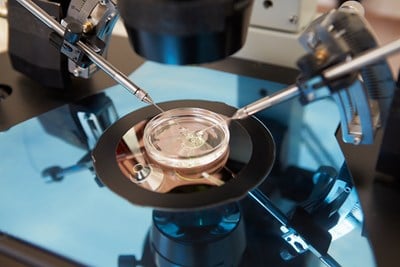In vitro fertilization (IVF) is a complex process of procedures that is used to treat infertility or genetic problems and ultimately assist with the conception of a child. If you and your partner are considering IVF, here are some important terms you should be familiar with.
- Infertility: This is a term used to describe not being able to get pregnant despite having carefully timed, unprotected sex for at least one year. 10% to 15% percent of couples in the United States struggle with infertility. There are many different types of infertility. Some can be treated by taking fertility medications; however, others require more complicated methods to achieve a successful pregnancy, such as in vitro fertilization.
- Ovulation induction: This is the first step in the IVF process, and it involves taking medications with synthetic hormones in order to stimulate your ovaries into producing multiple eggs, as opposed to the single egg that normally develops each month.
- Vaginal ultrasound: This is a technique that can be used to determine if your eggs are ready for collection after a few weeks of taking ovulation-inducing medications. A vaginal ultrasound is a procedure that uses sound waves to create an image of your ovaries and examine the development of your follicles, which are the fluid-filled sacs where eggs mature.
- Egg retrieval: This is the second step in the IVF process, and it is a procedure that is usually done in your doctor’s office or clinic. Using either transvaginal ultrasound or a laparoscope, your eggs are removed from the follicles through a needle that is connected to suction device before being placed in a nutritive liquid and incubated.
- Sperm retrieval: On the same day as the egg retrieval procedure, your partner will provide a sample of semen. Another option is to use donor sperm. Before fertilization, the sperm are separated from the semen fluid in a lab to increase the chance of success.
- Testicular aspiration: This is a surgical procedure that may be recommended by your doctor rather than collecting sperm using masturbation. Testicular aspiration involves using a needle to extract sperm directly from the testicle.
- Fertilization: The fertilization stage of the IVF process can be attempted in one of two ways. The most common method is insemination, which involves mixing healthy sperm and mature eggs and incubating overnight. Another method is intracytoplasmic sperm injection (ICSI), which involves injecting a single healthy sperm into each mature egg. This is sometimes a more viable option if there has been more than one failed attempt at in vitro fertilization.
- Pre-implantation genetic testing: If you or your partner have a genetic condition that you are worried about passing on to your children, then the embryo can be screened for this condition before it is implanted into your uterus.
- Embryo transfer: This procedure is the last step in the IVF process and usually takes places two to six days after the egg retrieval. If successful, the embryo transfer will implant into the lining of your uterus within six to ten days.
- Catheter: This is the tool that is used to transfer the embryos into your uterus. A catheter is a long, thin, flexible tube with a syringe containing the embryos attached to one end. The catheter is inserted into your vagina, through your cervix, and into your uterus where the embryos are deposited.



